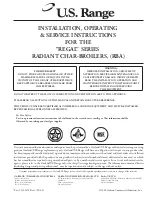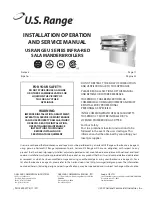
EL-DB N
3
EN
cod. 3541M741 - Rev. 00 - 07/2018
3.4 Burner connection
An oil or gas burner, with blown air for pressured furnaces, can be used if its operation
characteristics are suitable for the size of the boiler furnace and its overpressure. The
choice of burner must be made beforehand, following the manufacturer's instructions,
according to the work range, fuel consumption and pressures, as well as the length of
the firebox. Install the burner in compliance with the Manufacturer's instructions.
3.5 Electrical connections
Connection to the electrical grid
B
The unit's electrical safety is only guaranteed when correctly connected to an
efficient earthing system executed according to current safety standards. Have
the efficiency and suitability of the earthing system checked by professionally
qualified personnel. The manufacturer is not responsible for any damage
caused by failure to earth the system. Also make sure that the electrical system
is adequate for the maximum power absorbed by the unit, as specified on the
boiler dataplate.
The boiler is prewired and provided with a Y-cable and plug for connection to the elec-
tricity line. The connections to the grid must be made with a permanent connection and
equipped with a bipolar switch whose contacts have a minimum opening of at least 3
mm, interposing fuses of max. 3A between the boiler and the line. It is important to re-
spect the polarities (LINE: brown wire / NEUTRAL: blue wire / EARTH: yellow-green
wire) in making connections to the electrical line. During installation or when changing
the power cable, the earth wire must be left 2 cm longer than the others.
B
The user must never change the unit's power cable. If the cable gets damaged,
switch off the unit and have it changed solely by professionally qualified person-
nel. If changing the electric power cable, use solely
“HAR H05 VV-F”
3x0.75
mm2 cable with a maximum outside diameter of 8 mm.
Accessing the electrical terminal block
Undo the two screws
“A”
located on the top part of the control panel and remove the
cover
“B“
.
fig. 4 - Accessing the terminal block
3.6 Connection to the flue
The unit must be connected to a flue designed and built in compliance with current reg-
ulations. The pipe between the boiler and flue must be made from material suitable for
the purpose, i.e. heat and corrosion resistant. Ensure the seal at the joints and insulate
the entire pipe between boiler and flue, to prevent the formation of condensate.
4. SERVICE AND MAINTENANCE
All adjustment, conversion, start-up and maintenance operations described below must
only be carried out by Qualified Personnel (meeting the professional technical require-
ments prescribed by current regulations) such as those of the Local After-Sales Techni-
cal Service.
LAMBORGHINI
declines any liability for damage and/or injury caused by unqualified and
unauthorised people tampering with the unit.
4.1 Adjustments
Burner adjustment
Boiler efficiency and correct operation depend above all on accurate burner adjustments.
Carefully follow the Manufacturer's instructions. The two-stage burners must have the
first stage adjusted to a power level not below the boiler's rated min. power. The power
of the second stage must not be higher than the boiler's rated max. power.
4.2 Start-up
B
Checks to be made at first lighting and after all maintenance operations that in-
volved disconnecting from the systems or an operation on safety devices or
parts of the boiler:
Before lighting the boiler
•
Open any on-off valves between the boiler and the systems.
•
Check the seal of the fuel system.
•
Check correct prefilling of the expansion tank.
•
Fill the water system and make sure that all air contained in the boiler and the sys-
tem has been vented, by opening the air valve on the boiler and any air valves on
the system.
•
Make sure there are no water leaks in the system, domestic hot water circuits, con-
nections or boiler.
•
Check correct connection of the electrical system and efficiency of the earthing sys-
tem
•
Make sure there are no flammable liquids or materials in the immediate vicinity of
the boiler
Checks during operation
•
Light the unit on as described in sec. 2.3.
•
Make sure the fuel circuit and water systems are tight.
•
Check the efficiency of the flue and air/fume ducts while the boiler is working.
•
Make sure the water is circulating properly between the boiler and the systems.
•
Check proper lighting of the boiler by doing several tests, turning it on and off with
the room thermostat or remote control.
•
Make sure the fuel consumption indicated on the meter matches that given in the
technical data table on sec. 5.3.
•
Make sure the fumebox and burner door are tight.
•
Make sure the burner works properly. This check must be made with the special in-
struments, following the manufacturer's instructions.
4.3 Maintenance
Periodical check
To ensure correct operation of the unit over time, have qualified personnel carry out a
yearly check, providing for the following:
•
The control and safety devices must function correctly.
•
The fume evacuation circuit must be perfectly efficient.
•
Make sure there are no obstructions or dents in the fuel supply and return pipes.
•
Clean the filter of the fuel suction line.
•
Measure the correct fuel consumption
•
Clean the combustion head in the fuel outlet zone, on the swirl disc.
•
Leave the burner on at max. for about ten minutes, then analyse the combustion,
checking:
-
Correct setting of the elements specified in this manual.
-
Temperatures of fumes at the flue
-
CO
2
percentage content
•
The air/fume terminal and ducts must be free of obstructions and leaks
•
The burner and exchanger must be clean and free of deposits. For cleaning do not
use chemical products or wire brushes.
•
The fuel and water systems must be tight.
•
The water pressure in the system when cold must be approx. 1 bar; otherwise bring
it to that value.
•
The circulating pump must not be blocked.
•
The expansion tank (not supplied) must be filled.
A
The boiler casing, control panel and aesthetic parts can be cleaned with a soft
damp cloth, if necessary soaked in soapy water. Do not use any abrasive de-
tergents and solvents.
Boiler cleaning
1.
Disconnect the power supply to the boiler.
2.
Remove the front top and bottom panel.
3.
Open the door by undoing the knobs.
4.
Clean the inside of the boiler and the entire path of exhaust fumes, using a tube
brush or compressed air.
5.
Then close the door, securing it with the knob.
To clean the burner, refer to the Manufacturer's instructions.
4.4 Troubleshooting
Fault
Two shutdown conditions resettable by the user can occur :
A
Burner shutdown signalled by the special indicator. Refer to the burner manual.
B
Cutting in of the safety thermostat, which occurs when the boiler temperature
reaches a value beyond which a dangerous condition may be created. To re-
store operation, unscrew cap 3 of fig. 1 and press the reset button below.
If the problem persists, request the assistance of Qualified Personnel or the After-Sales
Centre.
In case of a fault and/or poor operation, deactivate the unit, do not try to fix the problem
or directly carry out any operation. Contact authorised and professionally qualified per-
sonnel.
A
1
2
B




































